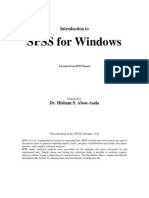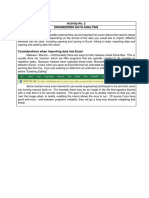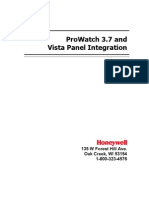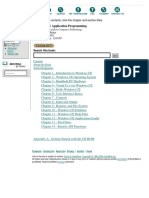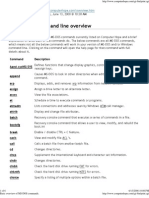Lab Assignment 1: Tutorial For Statgraphics Plus: Ie 355: Quality and Applied Statistics I
Uploaded by
huynh dungLab Assignment 1: Tutorial For Statgraphics Plus: Ie 355: Quality and Applied Statistics I
Uploaded by
huynh dungIE 355: QUALITY AND APPLIED STATISTICS I
LAB ASSIGNMENT 1:
TUTORIAL FOR STATGRAPHICS PLUS
Statgraphics is a statistical package for the PC in the Windows environment. It is
very easy to use and gives colorful, interesting graphics. It provides a means for you to
explore data with ease and curiosity. This document contains some basics about the
package and a tutorial.
Data is Organized into Spreadsheets
Data may be input directly into spreadsheets within Statgraphics or imported from
text files or other spreadsheet programs. For example, consider a data file that contains
information about cars. The three columns are horsepower, mpg, and carmakers. The
first column gives the horsepower for 100 car models; similarly, the second gives the
miles per gallon for each car model. The third column only contains three entries and is a
list of the countries that produce the cars. Note that two of the variables are numeric and
one consists of characters. Note that two columns contain 100 entries and the third
column only 3 entries.
How is the Data Stored?
We store data from Statgraphics into data files whose file extension is .sf3. Data
files are readable by Statgraphics only. Statgraphics provides a few sample data files.
These data files can be found in the directory (or folder) named C:\Program
Files\Statgraphics\STATGRAPHICS Plus 5.0\Test Data (do not store your personal
data in this directory! See instructions below.). The data for the example in the above
paragraph can be found in the sample data file cardata.sf in the given Statgraphics sample
data directory.
410942539.doc Page 1 of 10 3/4/2019
How are the Analyses Stored?
In Statgraphics you have several objects that comprise a project, for example, a
histogram, a data file, a control chart, and a gage analysis. We can save all of these
objects together into what Statgraphics calls a “StatFolio”. StatFolio files have the
extension .sgp. When we come back to the project at another time we can restore all the
data and analyses without having to redo the analyses.
Where to Save Your Data and StatFolios
When you complete part or all of an assignment you must save your work in your
own personal directory. That can be to a floppy disk or onto your personal drive Z:. For
example, you may choose to create a directory called Z:\IE355 to store the work you do
for this class.
Note: DCLICK means double click left mouse button; RCLICK means click right
mouse button. OK means click OK button.
One way to create a directory for this class:
Logon to the computer and press Start in the lower left corner of the screen.
DCLICK My Computer icon on the pop-up menu.
DCLICK Z: drive in right pane. Your last name is in front of Z:
CLICK File > New > Folder
You will see a folder icon and the text “New Folder” highlighted. Just start
typing a name for the folder, like, IE 355, then ENTER.
To Start StatGraphics
START>Programs>Math & Stats> StatGraphics Plus v5.0> sgwin
Exit the wizard pop-up if it shows up when starting.
410942539.doc Page 2 of 10 3/4/2019
Parts of the Screen
There are four parts that I will refer to in the tutorial.
MENU BAR is the line of words on the top: File, Edit, Plot, Describe, etc.
APPLICATION TOOLBAR is the row of icons just underneath - close file, open file,
save, cut, etc.
ANALYSIS TOOLBAR is the row of icons that appears within an analysis window.
TASKBAR BUTTONS are the icons on the bottom of the screen which include untitled
data, untitled comments, StatAdvisor, and StatGallery, and StatReporter buttons.
Tutorial Exercises
Create a new data file with two numeric variables and save it.
Start StatGraphics. An EXCEL like worksheet is displayed.
CLICK Col_1. The first column has been select and it becomes shaded.
RCLICK anywhere on worksheet.
CLICK Modify Column…. Change Name to Sales. Make sure that data is
specified as numerical, i.e., select the radio button next to Numeric. OK.
Note that the column name has changed. Sales gives the dollar amount sold
in $1000.
CLICK the first cell of Sales column, then enter value 0.407. Hit return and cursor
will be positioned at next cell. Here is the rest of the data:
(.407), .293, .276, .274, .255, .253, .248, .245, .240, .239, .223, .211, .
200, .189
CLICK Col_2. The second column becomes shaded.
410942539.doc Page 3 of 10 3/4/2019
RCLICK anywhere on worksheet.
CLICK Modify Column…. Change the name of this column to Units. Make sure
that data is type Numeric. OK. Note that the column name has changed.
Units gives the number of units sold.
CLICK the first cell of Units column, then enter value 10. Hit return and cursor will
be positioned at next cell. Here is the rest of the data:
(10),12, 8, 13, 22, 11, 41, 35, 38, 22, 26, 30, 50, 47
CLICK File > Save > Save Data File. Select your directory from the Save in drop
down box, i.e., Z:\IE355. Enter the filename cosmetic. Save.
CLICK File > Close > Close Data File. The data disappears.
CLICK underscore button in the upper right hand corner to reduce your spreadsheet
to a taskbar button.
Edit an Existing File. Add a new character variable and create a new
numeric variable that is a function of the first two.
CLICK File > Open > Open Data File
CLICK the data filename cosmetic.sf3. Open.
DCLICK the cosmetic.sf3 taskbar button to restore the spreadsheet.
CLICK Col_3. The third column becomes shaded.
RCLICK Modify Column. Change the name to Products. Also specify that data type
is Character. OK. Note that the column name has changed.
CLICK the first cell of Products column, then enter value prod01. Hit return and
cursor will be positioned at next cell. Here is the rest of the data: prod02,
prod03, ... , prod14
CLICK Col_4. The fourth column becomes shaded.
RCLICK Modify Column. Change the name to Avgprice. Also specify that data type
is fixed decimal with 2 decimal places. OK. Note that the column name has
changed. Avgprice is the average price per unit sold.
410942539.doc Page 4 of 10 3/4/2019
RCLICK the Avgprice column, and pick Generate Data. A dialog window appears
that allows you to enter a function. You can type the expression, or you can
DCLICK the buttons to help you type column names, numbers, and arithmetic
symbols and functions like sin, cosine, etc. Type in: Sales *1000/Units. OK.
CLICK File > Save > Save Data File.
CLICK File > Close > Close Data File.
Create a Statistics Analysis: Obtain summary statistics and print
Open data file cosmetic.sf3.
CLICK Describe > Numeric Data > One-Variable Analysis…. The one variable
analysis dialog window appears.
DCLICK the variable name Sales and it will appear in the Data text box. OK. An
Analysis Summary and a Scatter Plot of the variable sales appears. The left
pane is a tabular output showing number of entries and the range of the
variable. The right pane is a graphical output showing a plot of the data in the
order it appears in the column.
CLICK Tabular Options button on the Analysis Toolbar. It is the yellow button with
lines, second from left. A dialog window displays.
CLICK the Summary Statistics check box. OK. You see the left pane split into two.
The Summary Statistics gives statistics like: average, standard deviation,
maximum, minimum, etc.
CLICK File > Print…. A dialog window opens that allows you to select what to print.
(select Lucida console font if requested to pick a font) Select the radio button
for “All Text Panes”. The Analysis Summary and the Summary Statistics will
both print.
CLICK on the x in the upper right hand corner of the One-Variable Analysis window.
A dialog will appear asking if “OK to delete analysis?”. Answer, YES.
Close data file cosmetic.sf3.
Create a StatFolio - Data plus analyses
Statgraphics allows you to save data and analyses you have already performed into
a “StatFolio.” In this section, you will open the data file Qcdata and perform a One-
Variable Analysis on the variable burgers. This variable is the weight in ounces of burgers
made at the burger factory. This analysis will include the tabular results: Summary
410942539.doc Page 5 of 10 3/4/2019
Statistics and Stem-and-Leaf Display and the graphical results: Frequency Histogram, Box
Plot, and Normal Probability Plot. You will then save all this in a StatFolio.
Open data file Qcdata.sf found in:
C:\Program Files\Statgraphics\STATGRAPHICS Plus 5.0\Test Data
CLICK the underscore symbol top right to reduce the spreadsheet to a taskbar button.
CLICK Describe > Numeric Data > One Variable Analysis…. The one variable
analysis dialog window appears.
DCLICK the variable burgers and it will appear in the Data text box. OK. The tabular
output Summary Analysis and graphical output Scatter Plot appears.
CLICK Tabular Options button on the applications Toolbar. (This is the yellow
button, second from left). A dialog window displays.
CLICK Summary Statistics and Stem-and-Leaf Display check boxes. CLICK
Analysis Summary check box to unselect it. OK. The left portion of the
window will split into two panes: “Summary Statistics …” and “Stem-and-
Leaf …”.
CLICK Graphical Options button on the applications Toolbar (This is the black
button with tiny blue graph on it, third from left). A dialog window displays.
CLICK Frequency Histogram, Box-and-Whisker Plot, and Normal Probability
Plot. Uncheck Scatter Plot option. OK. You will now have 5 panes on your
screen: two tabular option panes on left and three graphical panes on right.
CLICK File > Save As > Save StatFolio As…. A dialog window displays. Make
sure to save this in YOUR Z:\IE355 directory. Use the file name Burgers in
the file name box and click Save.
CLICK File > Close > Close StatFolio. The data and the analyses disappear.
Add to the StatFolio with additional analyses about cereal and set up
a control chart.
So far, you have saved a StatFolio with for the burger variable. Now, you will
create the same analysis for another variable called cereal. To do this we do not have to
repeat the entire analysis, we can just make a copy of the burger analysis and use it for
cereal. Yum.
CLICK File > Open > Open StatFolio. Select Burgers.sgp from Z:\IE355 directory.
The Burgers StatFolio will appear.
CLICK Edit > Copy Analysis from the Menu bar to make the copy.
410942539.doc Page 6 of 10 3/4/2019
CLICK Input Dialog button on the application toolbar (it is Redish, first button from
left). The input dialog window will appear and allow you to choose another
variable.
DCLICK on cereal and cereal appears in the Data text box. OK. You will now have the
same five panes on your screen as with the burger variable but the analysis is
based on the cereal data.
CLICK underscore button, top right, to minimize the cereal analysis.
410942539.doc Page 7 of 10 3/4/2019
Now we create an X-bar control chart and an R control chart for the
cereal variable.
NOTE: Control charts will be introduced to you later in the term. Don’t worry if
you do not understand the concepts right now.
CLICK Special > Quality Control > Variables Control Charts > X-bar and R….
DCLICK cereal and it will appear in the Data text box just under the Observations radio
button
CLICK in the text box labled Subgroup Numbers or Size. Type 5. OK. The analysis
appears, i.e., one tabular output and one graphical output.
CLICK Graphical Options button on the Analysis Toolbar. Check both the X-bar
Chart and the Range Chart check boxes (only). OK. Only theRange control
chart appears.
Rename the StatFolio and save it as Burgers and Cereal in your Z:\IE355
directory. Close the analysis.
Prepare results of analyses for output.
Statgraphics offers two features to organize your results for printing and
distribution. The StatGallery allows you to arrange several panes (tabular or graphical) on
one page. The StatGallery is good for arranging many things onto one page but could be
hard to read and it does not allow you to add your own documentation.
The StatReporter creates a rich text document from the tabular and graphical
panes that you can edit with Word or Notepad. The StatReporter is better suited for
reports that are to be given to others to read.
410942539.doc Page 8 of 10 3/4/2019
Using StatGallery
Here we will arrange the One-Variable Analysis of the burger variable onto one
page and print using the StatGallery feature.
Open the statfolio for Burgers from your Z:\IE355 directory. (If it is not
already, restore the One-Variable analyses on burger so you can see it.)
DCLICK StatGallery taskbar button at bottom to restore the StatGallery window. You
should see four blank panes.
RCLICK in Summary Statistics pane from the One-Variable Analysis Window. Copy.
RCLICK upper left pane in StatGallery window. Paste. Summary Statistics tabular
data appears.
RCLICK in Stem and Leaf Display pane from the One-Variable Analysis Window.
Copy.
RCLICK lower left pane in StatGallery window. Paste.
RCLICK in Frequency Histogram graphical pane from the One-Variable Analysis
Window. Copy.
RCLICK upper right pane in StatGallery window. Paste.
Repeat for the Box-and-Whisker Plot. Paste it into lower right pane of
StatGallery.
RCLICK anywhere in StatGallery. Select Print…. A dialog window appears. OK.
Save the Burgers StatFolio. A dialog window appears “Save current
StatGallery?”. Select Yes. Name the StatGallery Burgers.sgg. Save. Close
the Burgers StatFolio.
410942539.doc Page 9 of 10 3/4/2019
Using StatReporter
Here we will arrange the One-Variable Analysis and the Xbar and R chart analysis
for cereal onto a single report and print using the StatReporter feature.
Open the statfolio for Burgers and Cereal from your Z:\IE355 directory. (If
it is not already, restore the One-Variable analysis on cereal so you can see it.)
DCLICK StatReporter taskbar button at bottom to restore the StatReporter window.
It should be blank.
RCLICK Anywhere in the one-variable analysis window. Choose Copy Analysis to
StatReporter…. All four panes are copied to the StatReporter window.
CLICK Anywhere in StatReporter to view the report.
Minimize the One-Variable analysis on cereal and restore the X-bar and R
chart analysis so that you can see it.
RCLICK Anywhere in the X-bar and R chart analysis window. Copy Analysis to
StatReporter…. Notice the control chart analysis is appended to the end of
the one-variable analysis in the StatReporter.
CLICK the StatReporter window. Mover the cursor to the top of the report. In size
20 font, type: “Cereal Analysis and Control Charts” Enter (twice). “Your
Name”. Enter (twice).
RCLICK Print…. OK.
Save and Close Burgers and Cereal StatFolio and StatReport in Z:\IE355.
Hand in print-outs stapled together in this order: Cereal Report, Burger Gallery,
and Cosmetic tabular outputs.
410942539.doc Page 10 of 10 3/4/2019
You might also like
- Psychology 311 - Introduction To Statistics Lab Manual: Diane Lane Washington State University VancouverNo ratings yetPsychology 311 - Introduction To Statistics Lab Manual: Diane Lane Washington State University Vancouver34 pages
- How To Do Descriptive Statistics in MS Excel 2007No ratings yetHow To Do Descriptive Statistics in MS Excel 20073 pages
- Introduction To Excel, Data Presentation and Descriptive StatisticsNo ratings yetIntroduction To Excel, Data Presentation and Descriptive Statistics8 pages
- Useful Commands in Excel: Data Tab, Data Analysis Should Appear in The Analysis GroupNo ratings yetUseful Commands in Excel: Data Tab, Data Analysis Should Appear in The Analysis Group2 pages
- Plotting Using Originpro 8.: Vytautas AstromskasNo ratings yetPlotting Using Originpro 8.: Vytautas Astromskas21 pages
- Microsoft Excel: Microsoft Excel User Interface, Excel Basics, Function, Database, Financial Analysis, Matrix, Statistical AnalysisFrom EverandMicrosoft Excel: Microsoft Excel User Interface, Excel Basics, Function, Database, Financial Analysis, Matrix, Statistical AnalysisNo ratings yet
- Stata Cheat Sheet: Command in "User" Menu Useful For What? Additional Options More InfoNo ratings yetStata Cheat Sheet: Command in "User" Menu Useful For What? Additional Options More Info2 pages
- Analytics On Spreadsheets and Data Visualization: Prof M.ShashiNo ratings yetAnalytics On Spreadsheets and Data Visualization: Prof M.Shashi31 pages
- Empowerment Technologies - Application Softwares - Spread SheetNo ratings yetEmpowerment Technologies - Application Softwares - Spread Sheet36 pages
- Microsoft Office Productivity Pack: Microsoft Excel, Microsoft Word, and Microsoft PowerPointFrom EverandMicrosoft Office Productivity Pack: Microsoft Excel, Microsoft Word, and Microsoft PowerPointNo ratings yet
- Analysis Procedures: Data Input Dialog BoxesNo ratings yetAnalysis Procedures: Data Input Dialog Boxes12 pages
- Statistics Toolbox 7: Perform Statistical Analysis, Modeling, and Algorithm DevelopmentNo ratings yetStatistics Toolbox 7: Perform Statistical Analysis, Modeling, and Algorithm Development6 pages
- Excel for Auditors: Audit Spreadsheets Using Excel 97 through Excel 2007From EverandExcel for Auditors: Audit Spreadsheets Using Excel 97 through Excel 2007No ratings yet
- Introduction To Matlab Lecture Advanced Data Analysis Jan2012No ratings yetIntroduction To Matlab Lecture Advanced Data Analysis Jan201250 pages
- Where can buy SPSS Stats Practically Short and Simple First Edition Sidney Tyrell ebook with cheap price100% (7)Where can buy SPSS Stats Practically Short and Simple First Edition Sidney Tyrell ebook with cheap price77 pages
- Techniques Adopted in Teaching Students Organic CHNo ratings yetTechniques Adopted in Teaching Students Organic CH10 pages
- Applying A Chemical Structure Teaching Method in The Pharmaceutical Analysis Curriculum To Improve Student Engagement and LearningNo ratings yetApplying A Chemical Structure Teaching Method in The Pharmaceutical Analysis Curriculum To Improve Student Engagement and Learning12 pages
- Capability Analysis Using Statgraphics Centurion: Neil W. Polhemus, Cto, Statpoint Technologies, IncNo ratings yetCapability Analysis Using Statgraphics Centurion: Neil W. Polhemus, Cto, Statpoint Technologies, Inc32 pages
- Cisco Identity Services Engine Installation Guide, Release 2.3No ratings yetCisco Identity Services Engine Installation Guide, Release 2.388 pages
- CIS SUSE Linux Enterprise 12 Benchmark v3.2.0No ratings yetCIS SUSE Linux Enterprise 12 Benchmark v3.2.0524 pages
- Instant download (Ebook) PowerShell Cookbook, 4th Edition by Lee Holmes ISBN 9781098101602, 9781098101541, 109810160X, 1098101545 pdf all chapter100% (7)Instant download (Ebook) PowerShell Cookbook, 4th Edition by Lee Holmes ISBN 9781098101602, 9781098101541, 109810160X, 1098101545 pdf all chapter67 pages
- El Secreto de Las Runas Guido Von List PDFNo ratings yetEl Secreto de Las Runas Guido Von List PDF2 pages
- How To Install SQL Server 2017 On RedHat Linux Without InternetNo ratings yetHow To Install SQL Server 2017 On RedHat Linux Without Internet8 pages
- Installing The IP Office Anywhere Demonstration Software: Release 10.1 Issue 02d January 2018No ratings yetInstalling The IP Office Anywhere Demonstration Software: Release 10.1 Issue 02d January 201833 pages
- Windows Deployment Error Diagnostic GuideNo ratings yetWindows Deployment Error Diagnostic Guide44 pages
- PSS Viper - 2004 Shaw Power TechnologiesNo ratings yetPSS Viper - 2004 Shaw Power Technologies436 pages
- Workflow Run Logs 2023 02 17 18 - 57 - 41No ratings yetWorkflow Run Logs 2023 02 17 18 - 57 - 412 pages
- Psychology 311 - Introduction To Statistics Lab Manual: Diane Lane Washington State University VancouverPsychology 311 - Introduction To Statistics Lab Manual: Diane Lane Washington State University Vancouver
- Microsoft Access for Beginners and IntermediatesFrom EverandMicrosoft Access for Beginners and Intermediates
- Introduction To Excel, Data Presentation and Descriptive StatisticsIntroduction To Excel, Data Presentation and Descriptive Statistics
- Useful Commands in Excel: Data Tab, Data Analysis Should Appear in The Analysis GroupUseful Commands in Excel: Data Tab, Data Analysis Should Appear in The Analysis Group
- Microsoft Excel: Microsoft Excel User Interface, Excel Basics, Function, Database, Financial Analysis, Matrix, Statistical AnalysisFrom EverandMicrosoft Excel: Microsoft Excel User Interface, Excel Basics, Function, Database, Financial Analysis, Matrix, Statistical Analysis
- Stata Cheat Sheet: Command in "User" Menu Useful For What? Additional Options More InfoStata Cheat Sheet: Command in "User" Menu Useful For What? Additional Options More Info
- Analytics On Spreadsheets and Data Visualization: Prof M.ShashiAnalytics On Spreadsheets and Data Visualization: Prof M.Shashi
- Empowerment Technologies - Application Softwares - Spread SheetEmpowerment Technologies - Application Softwares - Spread Sheet
- Microsoft Office Productivity Pack: Microsoft Excel, Microsoft Word, and Microsoft PowerPointFrom EverandMicrosoft Office Productivity Pack: Microsoft Excel, Microsoft Word, and Microsoft PowerPoint
- Statistics Toolbox 7: Perform Statistical Analysis, Modeling, and Algorithm DevelopmentStatistics Toolbox 7: Perform Statistical Analysis, Modeling, and Algorithm Development
- Excel for Auditors: Audit Spreadsheets Using Excel 97 through Excel 2007From EverandExcel for Auditors: Audit Spreadsheets Using Excel 97 through Excel 2007
- Introduction To Matlab Lecture Advanced Data Analysis Jan2012Introduction To Matlab Lecture Advanced Data Analysis Jan2012
- Where can buy SPSS Stats Practically Short and Simple First Edition Sidney Tyrell ebook with cheap priceWhere can buy SPSS Stats Practically Short and Simple First Edition Sidney Tyrell ebook with cheap price
- Techniques Adopted in Teaching Students Organic CHTechniques Adopted in Teaching Students Organic CH
- Applying A Chemical Structure Teaching Method in The Pharmaceutical Analysis Curriculum To Improve Student Engagement and LearningApplying A Chemical Structure Teaching Method in The Pharmaceutical Analysis Curriculum To Improve Student Engagement and Learning
- Capability Analysis Using Statgraphics Centurion: Neil W. Polhemus, Cto, Statpoint Technologies, IncCapability Analysis Using Statgraphics Centurion: Neil W. Polhemus, Cto, Statpoint Technologies, Inc
- Cisco Identity Services Engine Installation Guide, Release 2.3Cisco Identity Services Engine Installation Guide, Release 2.3
- Instant download (Ebook) PowerShell Cookbook, 4th Edition by Lee Holmes ISBN 9781098101602, 9781098101541, 109810160X, 1098101545 pdf all chapterInstant download (Ebook) PowerShell Cookbook, 4th Edition by Lee Holmes ISBN 9781098101602, 9781098101541, 109810160X, 1098101545 pdf all chapter
- How To Install SQL Server 2017 On RedHat Linux Without InternetHow To Install SQL Server 2017 On RedHat Linux Without Internet
- Installing The IP Office Anywhere Demonstration Software: Release 10.1 Issue 02d January 2018Installing The IP Office Anywhere Demonstration Software: Release 10.1 Issue 02d January 2018





